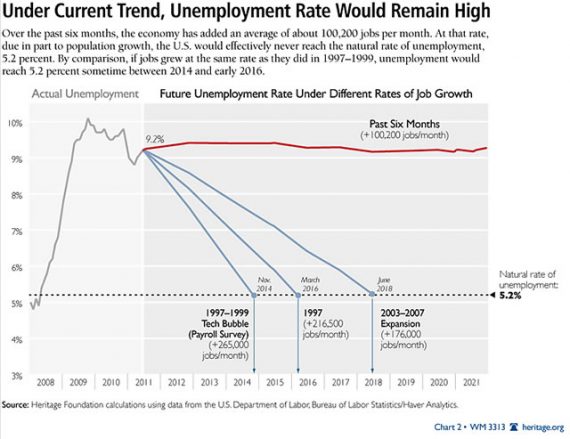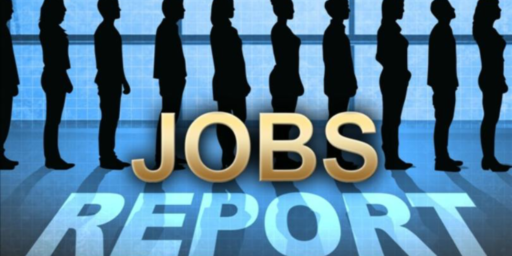Q: When Will The Jobs Come Back? A: Not For A Long Time
This chart from The Heritage Foundation is rather sobering:
Job creation in the first six months of the year was barely enough to keep pace with population growth. If the economy immediately began creating jobs at the pace it did in the 2003-2007 expansion (+176,000 jobs/month) then unemployment would not return to its natural rate (5.2 percent) until mid-2018
The new normal.






Considering that the Heritage Foundation once claimed that Pawlenty’s economic plan would lead to 2.8% unemployment(which is nearly impossible) then deleted the number online without changing the overall economic numbers hoping that no one would notice, I’d take anything that Heritage puts out there economically with a healthy grain of salt.
You claim that the question is answered – “not for a long time”. Why? What makes you so sure that job growth will remain almost flat? Or, at best, only increase at the rate of the weak recovery in the last decade?
The chart lays out various scenarios. What is the basis for your choice of which one will happen?
@Tano:
Even if we suddenly enter one of the biggest economic booms in American history, it would take seven years to recover. So even the best case is “not for a long time”.
@Stormy Dragon:
I wouldn’t call 2003-2007 one of the biggest economic booms…
If we would enter a Tech bubble, it would take a bit more than three years, according to the Heritage graph.
Didn’t we have this thread a month or two ago? If it was news then, could it still be news now?
I get that this is still a tough economy, technically a slow recovery, but the attempt to recycle the last year as “sudden and disastrous change” is bizarre.
I think it may be worse than the chart indicates. The “old normal” also had a lot of job turnover. The new normal does not. People are job locked – either they don’t have the prospect of a new, better-paying job to move up to because companies are not hiring, or they might have already retired but cannot because their retirement accounts got clobbered in the recession.
Example: a Local public schools teacher told me this spring that her system announced a tenure-track teaching position was open, and the personnel office received 5,000 applications.
That’s the new normal folks – the unemployment rate will worsen before it gets better because so many recent college grads went to grad schools rather than immediately try to get a career going. Those folks are just now starting to leave their post-grad degree programs, and we are about to get flooded with highly-qualified job seekers for whom there are no jobs.
Really, doesn’t the red line just tell us that if things stay the same they will stay the same?
Jobs aren’t coming back because consumers are broke. Until the middle class starts seeing real economic gains (which it hasn’t in over thirty years) that isn’t going to change.
Chad,
You do the math. It’s not hard. Excel spreadsheet it. It’ll even graph for you.
thats with a steady labor force participation rate, which is now at an all time low…assume people reenter the workforce, and its 2023 before we reach full employment
Duh…look at the recovery after the depression. It took a long time. Of course it took even longer because they got worried about debt, slashed spending, and caused a big setback. Thankfully we would never do that today. Oh…wait…